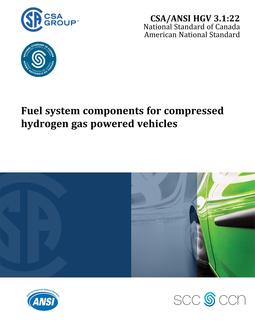PDF Standards CSA ANSI HGV 3.1:22

PDF Standards CSA ANSI HGV 3.1:22
Preface
This is the second edition of CSA/ANSI HGV 3.1, Fuel system components for compressed hydrogen gas powered vehicles. It supersedes the previous edition published in 2015. The major changes to this edition include the following: a) adding requirements for flexible fuel lines, hoses, and hose assemblies for use as part of a vehicle’s onboard fuel storage system or fuel delivery system; and b) harmonizing test procedures and values within the industry. CSA Group acknowledges that the development of this Standard was made possible, in part, by the financial support of Natural Resources Canada. This Standard is considered suitable for use for conformity assessment within the stated scope of the Standard. This Standard was prepared by the Subcommittee on Onboard Vehicle Components for Hydrogen Gas Vehicles, under the jurisdiction of the Technical Committee on Hydrogen Transportation and the Strategic Steering Committee on Transportation, and has been formally approved by the Technical Committee. This Standard has been developed in compliance with Standards Council of Canada requirements for National Standards of Canada. It has been published as a National Standard of Canada by CSA Group. This Standard has been approved by the American National Standards Institute (ANSI) as an American National Standard.
Scope
1.1 Inclusions This Standard establishes requirements for newly produced compressed hydrogen gas fuel system components, as listed below, that are intended for use on hydrogen gas powered vehicles: a) check valves (see Clause 8); b) manual valves (see Clause 9); c) manual container valves (see Clause 10); d) automatic valves and automatic container valves (see Clause 11); e) hydrogen injectors (see Clause 12); f) pressure sensors, temperature sensors, and pressure gauges (see Clause 13); g) pressure regulators (see Clause 14); h) pressure relief valves (PRV) (see Clause 15); i) pressure relief devices (PRD) (see Clause 16); j) excess flow valves (see Clause 17); k) gastight housing and ventilation passages (see Clause 18); l) stainless steel rigid fuel lines (see Clause 19); m) flexible fuel lines, hoses, and assemblies (see Clause 20); n) filter assemblies (see Clause 21); o) fittings (see Clause 22); p) non-metallic, low-pressure rigid fuel lines (see Clause 23); and q) discharge line closures (see Clause 24). Note: Other components not specifically covered here can be examined to meet the criteria of CSA/ANSI HGV 3.1 and tested according to the appropriate functional needs.
1.2 Applicability This Standard applies to devices that have a nominal working pressure of either 25MPa, 35MPa, 50MPa, or 70MPa, referred to in this Standard as the following pressure classes: a) “H25” — 25 MPa; b) “H35” — 35 MPa; c) “H50” — 50 MPa; and d) “H70” — 70 MPa. This Standard also applies to components downstream of the first stage of pressure reduction with a maximum operating pressure designated by the manufacturer in MPa or kPa (psi).
1.3 Exclusions This Standard does not apply to the following: a) hydrogen gas fuel system components incorporated during the manufacture of motor vehicles originally manufactured in compliance with the Federal Motor Vehicle Safety Standards (FMVSS) for Compressed Hydrogen Gas Fueled Vehicles and the Canadian Motor Vehicle Safety Standard (CMVSS); b) fuel containers; c) stationary power generation applications; d) container mounting hardware; e) electronic fuel management; or f) refuelling receptacles.
1.4 Conflicts In the case of a conflict between this Standard and federal, provincial, state, or local requirements, government requirements will take precedence.
1.5 Terminology In this Standard, “shall” is used to express a requirement, i.e., a provision that the user is obliged to satisfy in order to comply with the standard; “should” is used to express a recommendation or that which is advised but not required; and “may” is used to express an option or that which is permissible within the limits of the Standard. Notes accompanying clauses do not include requirements or alternative requirements; the purpose of a note accompanying a clause is to separate from the text explanatory or informative material. Notes to tables and figures are considered part of the table or figure and may be written as requirements. Annexes are designated normative (mandatory) or informative (nonmandatory) to define their application.
1.6 Units of measure The values given in SI units are the units of record for the purposes of this Standard. The values given in parentheses are for information and comparison only. All references to pressure throughout this Standard are to be considered gauge pressures, unless otherwise specified. Note: IEEE/ASTM SI 10 or ISO 80000-1 can be used as a guide in making metric conversion from yard/pound quantities.
Product Details
- Edition:
- 2nd
- Published:
- 09/30/2022
- Number of Pages:
- 109
- File Size:
- 1 file , 1.4 MB
- Product Code(s):
- 2429960, 2429960
- Note:
- This product is unavailable in Russia, Ukraine, Belarus